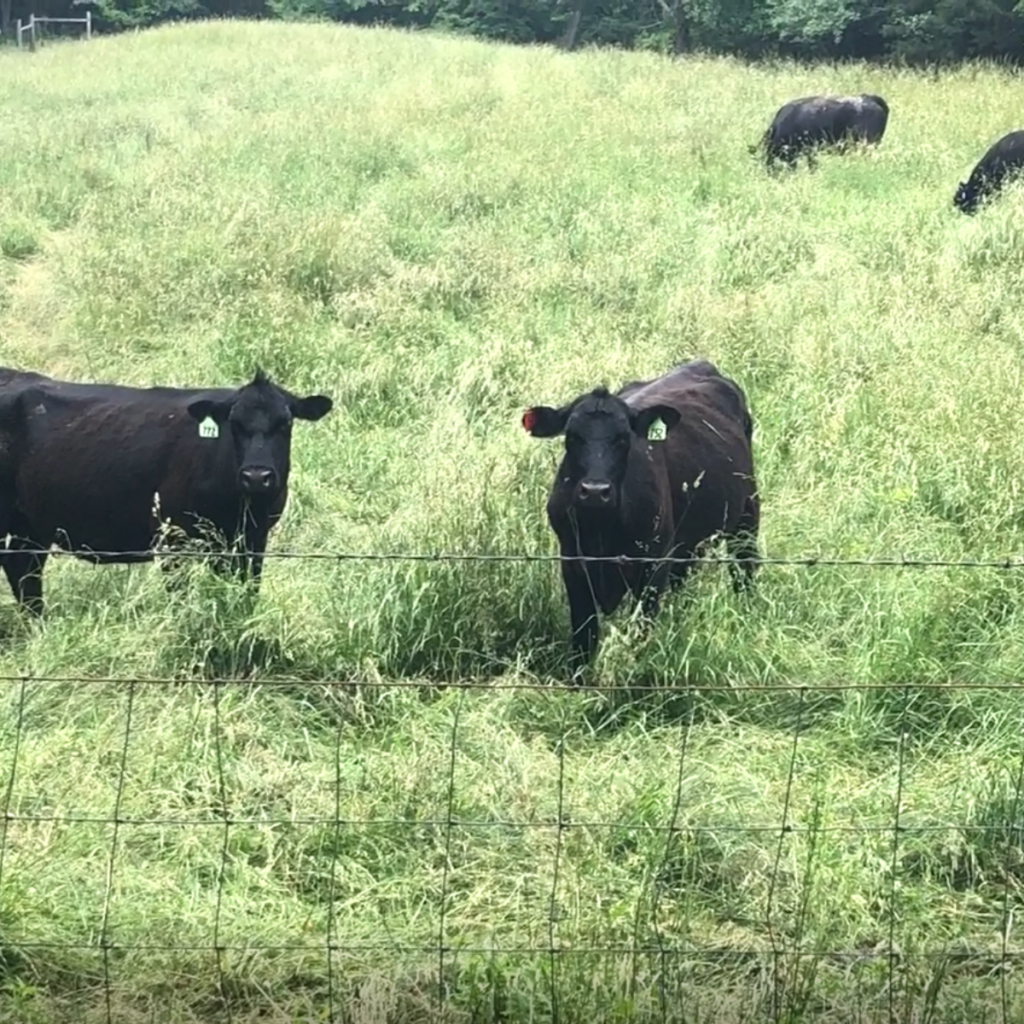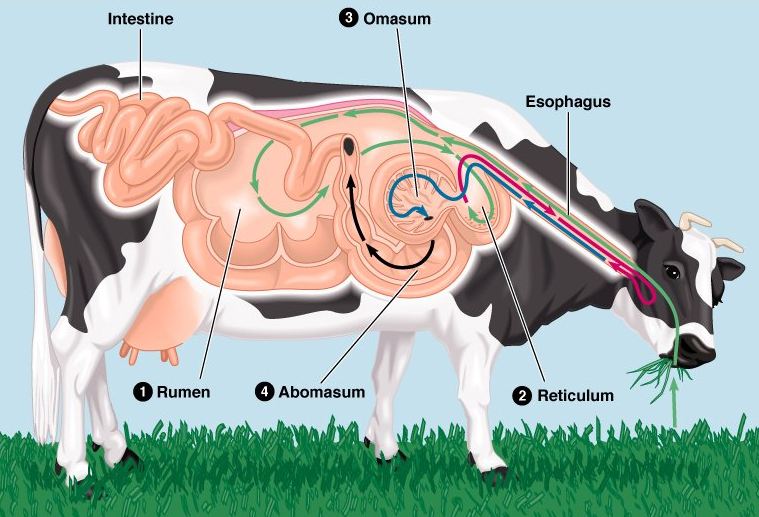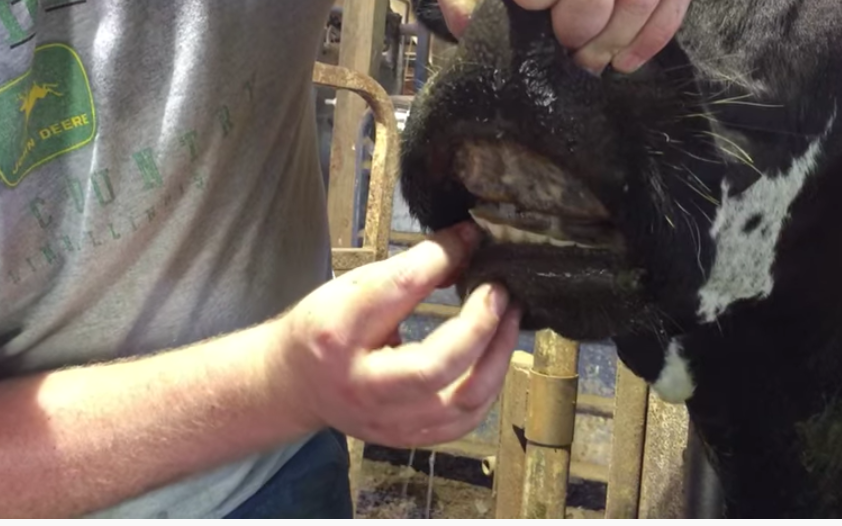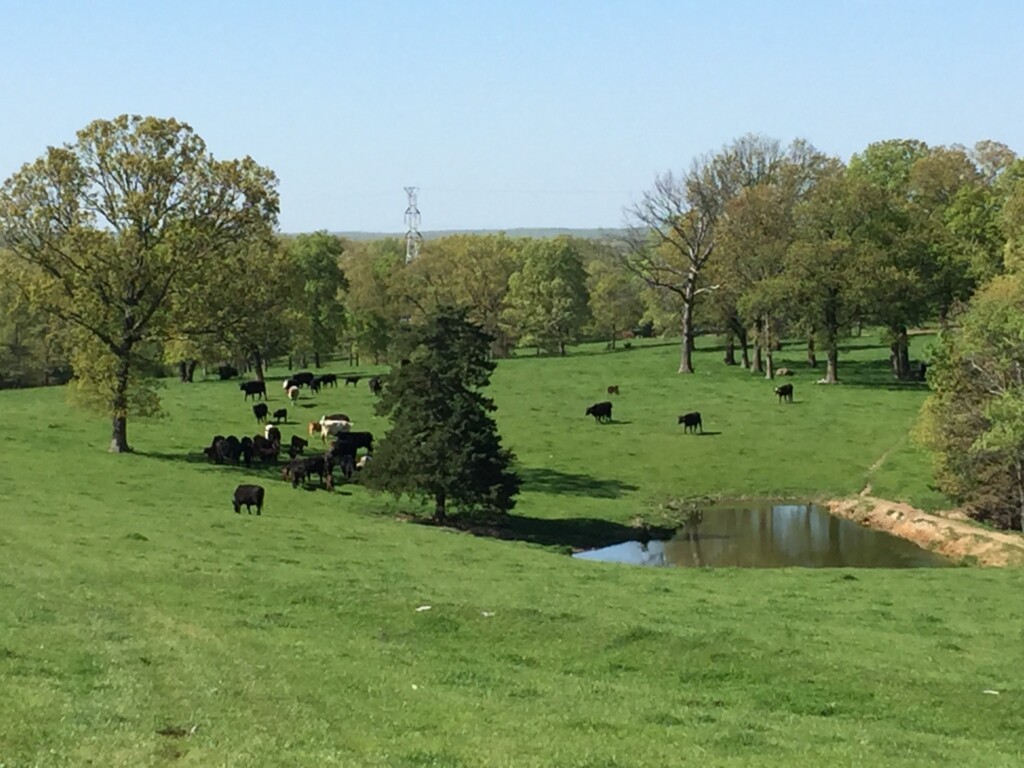What do cows eat? A cow’s diet is mostly made up of grass and hay. However, cattle eat other things too, and not all grass is created equal. Grass is very complex and its nutrient levels change throughout the year. We constantly monitor the condition of our grass and work with a cattle nutritionist so that our cows, calves and bulls are sure to get the nutrients, vitamins and minerals they need.

How do cattle get a complete and balanced diet when all they eat is grass? Grass is surprisingly complex.
When most people look at grass, they say it looks good if it’s green and mowed.
However, when a Farmer looks at grass, they see nutrition. Cattle farmers and ranchers know that to get the best meat, you have to have good grass. In fact, grass is so important that college classes are devoted to teaching farmers how to manage it and keep it as healthy as possible.
Pastures are typically comprised of grasses like bluegrass, ryegrass, fescue, bermudagrass, foxtail, sorghum. In addition, beef cows eat other naturally occurring (non-grass) pasture vegetation such as legumes, alfalfa and clover.
Jump to:
Cattle digestive system
Most people know the importance of a balanced diet. For humans, we try and “eat the rainbow” to get the vitamins and minerals we need. However, cows have a very different digestive system, which lets them thrive on a diet predominantly made up of grass.
Cattle, sheep, and goats are known as ruminants. They have a four-chamber stomach so they can digest grass and hay. The four chambers are called the rumen, reticulum, omasum and abomasum.

The largest chamber, or pouch, in the stomach is called the rumen. The name “ruminant” comes from this chamber. The purpose of the rumen is to hold and ferment food. In a mature cow, the rumen is very large – about the size of a 55-gallon trashcan. The rumen has been compared to a large food processor because it has millions of tiny organisms that live there naturally and help the cow get the nutrients it needs from the grass.
Cow’s teeth and tongue
Cows are unique because they have fewer teeth than most animals. Cattle have 32 teeth — six incisors or biting teeth, and 2 canines in the bottom front of the jaw. In place of the top incisors, there is a hard leathery pad known as a dental pad. Due to this, cows use their tongue to grasp a chunk of grass and bite it off.
When a cow takes its first bite of grass, they grab it with their tongue and then press their sharp bottom teeth against the top of their mouth, which is a hard palate. This then cuts the blades of grass so they can chew the grass. Then, it chews its food in the back using a side-to-side motion.
As a fun side-note, you can tell a cow’s age by checking their teeth. Here’s a video where we’re checking a cow’s teeth.

Chewing their cud
Cattle don’t chew grass much before swallowing. The forage mixes with saliva and is swallowed quickly down the esophagus and goes into the rumen. Once they fill up on grass, they find a place to lie down and chew the grass more thoroughly. Then, they voluntarily “un-swallow” or burp up a mixture of what they’ve already eaten, re-chew, and re-swallow. They do this over and over again. This process is technically called rumination, but it’s more common to hear it as “chewing the cud. A “cud” is food that the cow brings back up to chew again. Cows can spend as many as eight hours a day chewing their cud.
Nutrients in grass
Grass’s nutritional value varies throughout the year. As a farmer, the condition of our grass is of utmost importance so that we’re sure our cattle get the nutrients they need. In short, if you want good beef you have to have good grass.

In general, pasture grasses have two stages of growth—vegetative (spring growth) and mature (mid-to-late summer). Usually, the nutrient content is highest during the spring when there is new growth, good temperatures and rainfall. Mature or dormant grass in late fall and winter has much lower energy and protein content and overall digestibility when compared to a spring pasture.
For example, when we have a wet winter and spring, we know that will increase the soil moisture level. This in turn means better grass for the livestock to eat during the spring and summer. It also means we will usually be able to make more hay per field, which we will use during the upcoming winter.
Whether or not the grass has lots of nutrients or not will also affect the beef a little. If there are lots of nutrients, like in spring grass, cows will convert the extra nutrients to fat. Conversely, if there are less nutrients in the grass, like dormant fall grass, cows use all of the nutrients immediately.
What do cows eat besides grass?
An ideal pasture has a mixed type of grass and legumes, which are plants like clover, lentils, alfalfa, and beans. Legumes have a higher protein level than most grass, and may stay greener after some of the pasture grasses mature and lose nutrient quality.
Our pastures have several different types of legumes, including clover. In fact, one of the reasons we named our business “Clover Meadows Beef” is because of the clover in our fields that our beef cattle love.
Another way farmers can extend the life of grass is to make silage. Silage is grass, clover, alfalfa, and other organic matter that is fermented to preserve nutrients for later use. Since silage is fermented, it can be easier for cows to digest.
Depending on the time of year and the availability of grass, farmers may also feed cattle grain like corn, soybeans, sorghum, barley and oats. This mixture of grains is sometimes called a Total Mixed Ration, which is a method of feeding cows that combines feeds formulated to a specific nutrient content into a single feed mix so that each animal gets a balanced diet. Here’s a post and video of us feeding cattle on a typical day.
A cow’s diet
A cow will consume about 2.5-3% of their body weight a day. If the cow weights, 1,000 pounds, that means they’re eating 25-30 pounds of grass and legumes a day. If a person ate like a cow, they would have to eat about 360 cheeseburgers and drink 600 cartons of milk every day.
A good pasture in Missouri with lots of high-quality grass may support one cow per two acres during a good growing year.
A pasture with sparser grass (like you find in northwestern states like Montana and Wyoming) may only support one cow on 50 acres or more.
Supplementing cattle’s diet
If it’s been an extremely dry spring or summer, or a really long winter, there are times the grass doesn’t have the nutrients it needs to keep our cows healthy. When that happens, we will occasionally supplement our cattle’s diet so that they stay healthy. This is similar to a person taking a multi-vitamin to make up for whatever nutrients they’re not getting from their daily diet. Supplements for cows include things like molasses; high protein range cubes that are all-natural; or a diet designed by our veterinarian or cow nutritionist.
What do cows eat in winter when grass isn’t available?
From late fall to early spring, our cattle eat lots and lots of hay. We’ve talked a lot about making hay in previous articles.
On our farm, a cow’s food intake will increase by about 20 percent in the winter. On average, one cow will eat five large bales during a typical winter. Each bale weighs about 600 lbs.
This means we are constantly providing them with quality hay that we’ve cut and stored earlier in the year. If needed, we also provide additional, veterinarian-prescribed mineral and supplements to keep them healthy in the winter.
Hay is dried grass. Some farmers buy hay from other farms, but we’re blessed to have lots of pasture, so our hay comes directly from our farm.
Managing grass
Managing grass is critical on any cattle farm, and we do this by “rotational grazing”. This is an agriculture-term that means we move cows from one field to the next so that they’re always getting the best grass. It also gives the grass and field a chance to rest and grow.
We have several large pastures, and we rotate cows to those pastures every three to four weeks so they get new grass. If we didn’t do rotational grazing our fields would have what’s called “spot grazing.” Cows like to graze and eat, but they’re also somewhat selective (but not nearly as picky as horses). Cows will always eat their favorite grass first. This means in a pasture containing several grass species, a patchy grazing pattern can develop because cows leave their least-favorite grass until last.
Our cows are usually moved to pastures that have grass about four to six inches tall. The reason for this is because we want them to eat the grass before it starts to form a seed. When grass starts to form a seed, the plant has matured and it stops making nutrients. We want our cattle to get all the nutrients they can, so if they’re in fields with grass about four to six inches tall, the grass is still making nutrients.
Treating grass with fertilizer
We fertilize our grass to make sure that it’s as healthy as possible. This sometimes raises questions about “what’s in fertilizer”, so let us explain.
Fertilizer is made up of nitrogen (N), phosphorus (P), and potassium (K), which are the three basic elements of all plant life (you’ll see “NPK” on just about any bag of fertilizer you buy for your own yard too). When we fertilize, we’re adding back in the natural elements that were in the grass originally.
Applying fertilizer is something we take very seriously since it’s so important that our grass is healthy. Before applying any fertilizer, we do soil tests and get professional recommendations on what our grass may need.
Additionally, we apply Lime to the fields every three to five years based on soil tests. Lime helps keep our fields healthy because it helps release more nutrients from the soil by balancing the soil pH. Lime also contains calcium and magnesium — which makes those nutrients more available for the grasses. Learn more about how we liming field for cattle here.
The average cow we raise has 175 pounds of calcium in their bodies. The lime helps keep their calcium levels where they should be while they’re growing. Without added lime, over the years the soil would deplete of calcium.
Burning fields
When a farmer burns a field, he is adding organic matter back into the soil and decreasing unwanted plants and brush that may decrease nutrition.
One more thing!
Do you want to learn more about beef? Join our weekly e-newsletter where we share farm happenings, recipes and beef availability. Sign-up and get a cheat sheet with 9-must-ask questions before buying beef directly from a farmer. Or, we have an entire ebook about beef that goes through purchasing and preparing beef from a cattle farmers perspective.
Here are a few other links you may like:
- Do Cows Have Teeth?
- What everybody ought to know about beef cuts
- Buying a Cow. How Much Beef Is It?
- 7 Steps to Grilling a Steak to Perfection
- How We Raise Our Grass Fed Beef
- Easy Beef Brisket Recipe (oven-roasted)
- The Best Farm Books for Kids
Disclosure: This post contains affiliate links. This means if you click on the link and purchase the item, we will receive an affiliate commission at no extra cost to you. All opinions are our own and we only recommend products that we truly believe in.
We participate in the Amazon Services LLC Associates Program, an affiliate advertising program designed to provide a means for us to earn fees by linking to Amazon.com and affiliated sites. See our disclosure policy for more details.


Leave a Reply